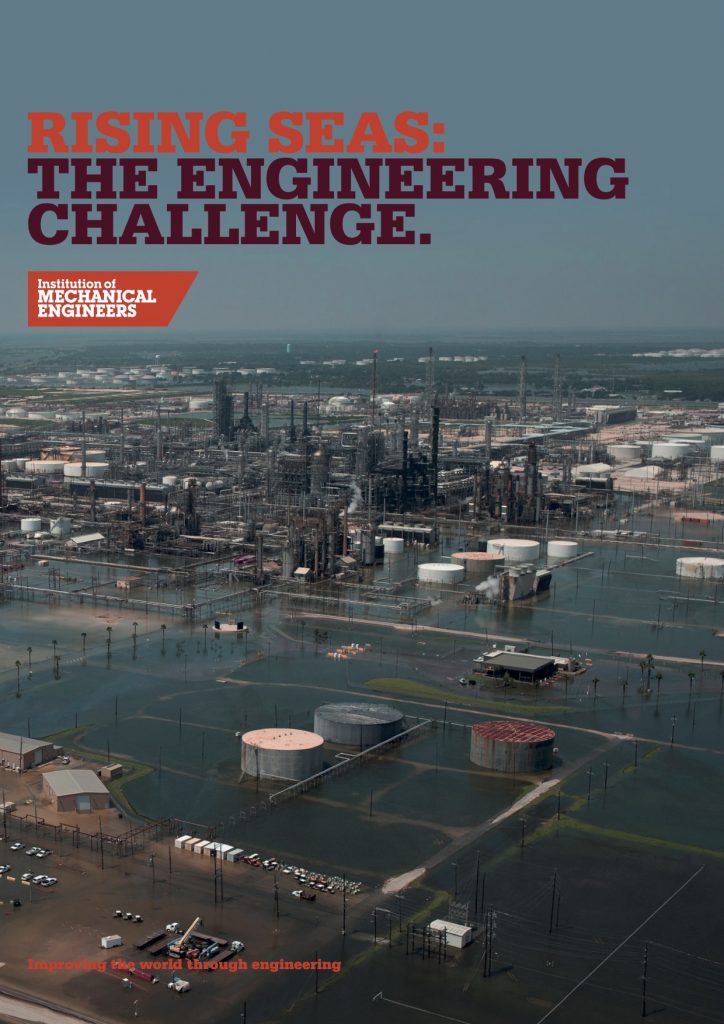British Engineers Use “9 Box Matrix” As Flood Design Guide

Today the British Institute of Mechanical Engineers, “IMechE”, issued guidelines for their 130,000 members to use when engineering for rising sea level. I am delighted that it is based upon a tool that I created a few years ago, the “9 Box Matrix.” The announcement was done at a press conference at their HQ in London, which I attended.
The report RISING SEAS: THE ENGINEERING CHALLENGE can be downoladed from their website: www.imeche.com
As shown below, the 9 Box Matrix is a simple construct with three rows for different risk levels and three columns for different time horizons. As a standard, I use 30, 50, and 100 years, though that can be varied for specific users who might need shorter or longer timeframes.
The Institute of Mechanical Engineers have now labeled this the “Englander 9-Box Matrix”, a bit humbling. It gives rather straight-forward guidance for planning for future flooding from rising seas, in addition to whatever current flooding a location may be experiencing. It aims to make the distinction that designing a soccer field has low risk sensitivity but a nuclear power plant would have high risk sensitivity. Accordingly, the safe-design guidance for future flooding ranges from one foot (30 cm) for the 30 year low risk, to 20 feet (6 meters) for the hundred year high risk, which would carry out roughly to the year 2120.
|
Risk Sensitivity |
30 Years* | 50 Years | 100 Years |
| Low | 30 cm (1 ft) | 60 cm (2 ft) | 2 m (7 ft) |
| Medium | 60 cm (2 ft) | 1.3 m (4 ft) | 4 m (13 ft) |
| High | 1 m (3 ft) | 2 m (7 ft) | 6 m (20 ft) |
The years theoretically are from a base year of 2020, but in fact are approximations. The actual amounts and metric equivalents of recommended increased building heights are all rounded upward, appropriate as they are approximations.
Besides the simplicity, the innovation here is to recognize that we cannot accurately forecast how much of Antarctica and Greenland will melt over the next hundred years. There are simply too many variables and uncertainties that will affect how those two mile-high ice sheets will melt, collapse, and break off into icebergs. When it comes to planning for rising seas over the next hundred years, there are many “known unknowns” and many “unknown knowns” to use the famous phrase of former Secretary of Defense, Donald Rumsfeld.
The actual increase of global mean sea level will depend on how warm the world gets, which in turn depends on the level of carbon dioxide in the atmosphere, which in turn will depend on the method used to produce the energy; coal versus renewables. Also we may be successful at industrial scale removal of CO2 from the atmosphere as the century progresses. Then there is the question of how much methane will escape into the atmosphere from the thawing permafrost and the subsea methane slush. Methane is about a hundred times more potent than CO2 as a greenhouse gas. All of those will affect future sea level, which in turn determines the global coastline.
So rather than ask exactly how high the water will get, the safer question is to ask how high to design buildings and infrastructure. Thus, in effect my 9-Box Matrix incorporates a margin of safety as is typically done with engineering specifications. This is a fundamental difference compared to most of the current focus on projections for rising sea level, which attempt to be precise, but have a wide range and keep changing. Given that buildings and infrastructure often last a hundred years, attempting to precisely predict how high the water will be is unrealistic, if not naive and risky.
A web page with version 1.1 of the 9 Box Matrix, with some notes and explanations can be downloaded from my website or from the nonprofit Rising Seas Institute, www.risingseasinstitute.org/englander9boxmatrix Anyone is welcome to share and use this, under Creative Commons, with attribution.
